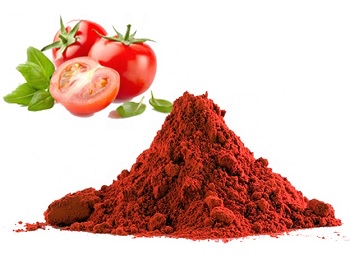Lycopene химические свойства, назначение, производство
Описание
Lycopene is a red-colored carotenoid found in tomatoes and other red fruits and vegetables. Carotenoids, including lycopene, are powerful antioxidants that efficiently quench singlet oxygen. Presumably through this action, carotenoids may protect against cancers, cardiovascular stress, and other diseases.
Химические свойства
Lycopene is a white to pale-yellow solid; balsam oriental aroma. Lycopene extract from tomato is a dark-red viscous liquid. It is freely soluble in ethyl acetate and n-hexane, partially soluble in ethanol and acetone, and insoluble in water. A solution in n-hexane shows an absorption maximum at approximately 472nm.
Lycopene (from the Greek word lykopersikon, meaning tomato) is a bright red carotene and carotenoid pigment. The natural resources are red fruits and vegetables, such as tomatoes, pink grapefruit, watermelon, and apricots. After absorbing from the stomach, lycopene is transported in the blood and accumulates in the liver, adrenal glands, and testes. Lycopene has been used to prevent carcinogenesis, cardiovascular diseases and aging.

From a chemistry perspective, lycopene is a symmetrical tetraterpene assembled from 8 isoprene units, containing 11 conjugated and 2 non-conjugated double bonds between carbon atoms. Lycopene is a member of the carotenoid family, and the predominant source in the human diet comes from tomato and tomato-based products. The antioxidant capacity of tomato strongly depends on the content and bioavailability of lycopene in the fruit. There is strong correlation between lycopene content in tomatoes and antioxidant capacity.
Вхождение
Lycopene is a carotenoid that occurs naturally in tomatoes.
Использование
Lycopene extract from tomato is intended for use as a food colour. It provides the similar colour shades, ranging from yellow to red, as do the natural and synthetic lycopenes. Lycopene extract from tomato is also used as a food/dietary supplement in products where the presence of lycopene provides a specific value (e.g., antioxidant or other claimed health benefits). The product may also be used as an antioxidant in food supplements.
Lycopene extract from tomato is intended for use in the following food categories: baked goods, breakfast cereals, dairy products including frozen dairy desserts, dairy product analogues, spreads, bottled water, carbonated beverages, fruit and vegetable juices, soybean beverages, candy, soups, salad dressings, and other foods and beverages.
Определение
ChEBI: An acyclic carotene commonly obtained from tomatoes and other red fruits.
Методы производства
Lycopene extract from tomato is produced from a tomato variety with high lycopene content, within the range of 150 to 250 mg/kg. This particular variety is not generally marketed for direct consumption, but is used primarily in the production of this lycopene extract. The extract is produced by crushing tomatoes into crude tomato juice that is then separated into serum and pulp. The tomato pulp is then extracted with ethyl acetate. The final product is obtained after solvent removal by evaporation under vacuum at 40-60°C.
Общее описание
Lycopene is a naturally occurring red pigment, which belongs to the family of carotenoids. It is found in tomatoes, watermelon and papaya. Lycopene has antioxidant property.
Биологическая активность
Lycopene may act as an inhibitor of tumor cells. In one study, lycopene was shown to inhibit PDGF-BB-induced signalling and cell migration in human cultured skin fibroblasts (Wu et al., 2007). Trapping of PDGF by lycopene compromised melanoma-induced fibroblast migration and attenuated signalling transduction in fibroblasts (Wu et al., 2007). In functional studies, lycopene inhibited melanoma-induced fibroblast migration in a noncontact coculture system and attenuated signalling in fibroblasts simulated by melanoma-derived conditioned medium (Chiang et al., 2007).
Механизм действия
Lycopene is a red carotenoid compound found in pink grapefruit, papaya, wolfberry, goji, and tomatoes Dietary supplementation with tomato-based products appears to lower biomarkers of
oxidative stress and carcinogenesis. Limited available evidence from small human intervention studies
indicate that lycopene supplementation for 10–12 weeks may decrease UV-induced erythema. Although
the bioavailability of lycopene in raw tomatoes is low due to tight binding with indigestible fiber, lycopene can be released from the food matrix through heating and food processing.
The effect of topical lycopene is not well characterized. An in vivo study using SKH-1 hairless mice
found that topical lycopene reduced the activity of ornithine decarboxylase (ODC) and myeloperoxidase
(MPO), enzymes that have been implicated in the carcinogenic and acute inflammatory effect of UVB
irradiation.
разработк И противоопухолевых препаратов
Lycopene is a naturally occurring chemical that manifests as a red pigment contained in common foods such as tomatoes, pink grapefruits, guava, and watermelon (Giovannucci 1999). This is a very strong antioxidant that has been found to prevent and even reverse the progression of prostate cancer, as well as treating benign prostatic hyperplasia. In a recent study, 30 mg a day of lycopene showed curative results in prostate cancer. For best results, supplements are recommended alongside eating and drinking plenty of lycopene-containing food and juices (Jatoi et al. 2007). Earlier research showed that taking a specific combination of lycopene, selenium, and saw palmetto by mouth for 8 weeks reduced pain in men with prostate swelling and pelvic pain more significantly than saw palmetto alone (Feifer et al. 2002).Lycopene shows anticancer activity against prostate, endometrial, breast, and colon carcinomas. It inhibits human cancer cell proliferation by activation of cancer-preventive enzymes like phase II detoxification enzymes, by suppression of insulin-like growth factor-I-stimulated growth (Wang et al. 2012). It also activates antioxidant enzymes like GST, GSH, and GPx and protects from oxidative stress caused by carcinogens. It alters PI3K/AKT pathway and ERK and Bcl-2 signaling in pancreatic and gastric carcinoma cells, respectively (Singh et al. 2016b).
Методы очистки
Crystallise lycopene from CS2/MeOH, diethyl ether/pet ether, or acetone/pet ether. Also purify it by column chromatography on deactivated alumina, CaCO3, calcium hydroxide or magnesia. It is oxygen sensitive and is stored in the dark, in an inert atmosphere. Also purified like -Carotene. [Beilstein 1 III 1076, 1 IV 1165.]
Lycopene препаратная продукция и сырье
сырьё
Магния оксид
ψ,ψ-Carotene, 5-cis-
(2E,4E,6E,8E,10E,12E,14E)-2,6,11,15-Tetramethyl-2,4,6,8,10,12,14-hexadecaheptenedial
dodecanedial
(E, E, E) -2,7-диметилокта-2,4,6-триендиал
препарат